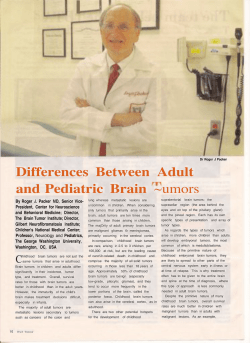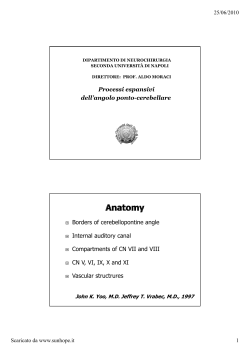
Brain Tumors: Neurosurgical treatment (including Gamma Knife) An Introduction
Brain Tumors: Neurosurgical treatment (including Gamma Knife) An Introduction The LSU-Shreveport Department of Neurosurgery Presenting Authors: Neurosurgery Residents & Faculty Brain Tumors: Classification • Categorized & Considered by cell layer of origin • World Health Organization (WHO) Classification: – – – – – – – Tumors of Neuroepithelial tissue Tumors of Meninges Tumors of Craniospinal Nerves Hematopoietic Neoplasms Germ Cell Tumors Sellar Tumors Metastatic Tumors Common Intracranial Tumors • Metastatic tumors to brain (lung, breast, renal, GI most freqeuent; melanoma has highest affinity for brain) • Gliomas (astrocytoma, anaplastic astrocytoma, glioblastoma multiforme) • Meningioma & Hemangiopericytoma • Pituitary adenoma • Craniopharyngioma • Vestibular schwannoma (a.k.a. acoustic neuroma) & Neurofibroma • Lymphoma • Pineal region tumors • Cystic lesions which mimic intracranial tumors • Inflammatory lesions which mimic intracranial tumors • Infectious lesions which mimic intracranial tumors Brain Tumors in General • Presentation – Headache, seizure, neurological deficit • History – Progressive onset of symptoms (weeks to months) • Physical Exam – Depends upon brain region affected • Diagnostic Imaging Studies – CT, MRI, PET (if r/o necrosis) • Diagnostic Laboratory Studies – Important for systemic tumors, e.g. leukemia • Treatment – Varies per histology of specific tumors • Prognosis – Varies per histology of specific tumors http://www.neurobc.com/conditions/Brain_metastases.htm Metastatic Brain Tumor • History – – Rapidly progressive onset of symptoms (weeks vs. months) Most common sources are LUNG, BREAST (in women), RENAL, & G.I. tract • Diagnostic Imaging Studies – – MRI: Tumor at grey-white matter junction, usually associated with edema Systemic work-up includes CT scan of chest and abdomen • Diagnostic Laboratory Studies – Liver function tests, CBC w/diff • Treatment – – – For solitary lesion or less than 4 lesions all < 3 cm. – biopsy if undiagnosed, plus Gamma Knife For > 3 cm. tumor, surgery followed by WBRT For > 4 lesions, biopsy for diagnosis, plus whole brain radiation therapy • Prognosis: 7 – 12 mos. http://www.neurobc.com/conditions/Brain_metastases.htm Gliomas • Presentation – Depends upon brain location, usually H/A over several mos., seizure, word finding difficulty • Physical Exam – Depends upon brain region affected • Diagnostic Imaging Studies – CT, MRI Astrocytoma – Note absence of edema • Treatment – Surgery, Radiation, Chemo (varies/age group & type) • Survival depends on pathology: – – – – Pilocytic astrocytoma: resection Æ cure; Grade 1 Astrocytoma (nuclear atypia) – 8-10 yrs; Grade 2 Anaplastic astrocytoma (+endothelial proliferation) – 2 yrs. Grade 3 (+necrosis) GBM – 11 months GBM – Note crossing of corpus callosum http://www.neurobc.com/conditions/ http://sprojects.mmi.mcgill.ca/braintumor/section2/subsection1/Default.htm Meningioma & Hemangiopericytoma • Presentation – – Meningiomas occur in middle aged females more frequently Hemangiopericytomas occur in younger patients • History – Meningiomas are usually slow-growing (months to years) vs. hemangioperictyomas (months) • CT/MRI: Show meninges-based tumor (usually), with variable amount of edema • Treatment – – Meninigiomas: Gross total resection Æ cure; Hemangiopericytomas: Surgical resection + XRT • Prognosis – – Meningiomas: Can be cured with gross total resection Hemangiopericytomas: Variable, depends upon recurrence http://sprojects.mmi.mcgill.ca/braintumor/section2/subsection1/Default.htm Pituitary adenoma • Presentation – Headache, visual defect (classically bitemporal hemianopsia), endocrine abnormalities (dependent upon hormone secreted) – Cushing’s disease is life-threatening (w/hypertension, stria, buffalo hump, morbid obesity); Prolactin, GH, TSH, FSH/LH also present • History – Slow-growing, over months to years • Diagnostic Laboratory Studies – Endocrine panel (with hormones noted above); can test IGF-1 for GH-secreting tumor; use dexamethasone suppression test for Cushing’s disease vs. ectopic Cushing’s syndrome • Treatment – Surgical excision usually initial treatment (usually transnasal approach), with GK for recurrence vs. local focused radiation • Prognosis – Generally benign, so proportional to gross total resection & control of endocrine effects; Cushing’s disease is life-threatening, http://www.medschool.lsumc.edu/Nsurgery/case23.html so remove pituitary gland if necessary http://www.clevelandclinic.org/neuroscience/treat/brain/neuroendocrine.htm Craniopharyngioma • Presentation – More common in younger children and older adults • History – Endocrinologic abormality, often diabetes insipidus • Skull X-ray/CT: Often calcified mass near hypothalamic area • Diagnostic Laboratory Studies – R/O D.I.: Serum sodium > 145, Urine specific gravity < 1.005, with clear dilute urine upto 10,000 cc/day! • Treatment – Surgical resection and/or focused radiation • Prognosis – 5-year survival 55%; mortality 10% usually from hypothalamic injury http://www.rbrs.org/database/82-3/page130.html Vestibular schwannoma • Presentation – Hearing difficulty in affected ear, vertigo, headache/facial weakness/facial numbness if large tumor • Physical Exam – Evaluate facial weakness & hearing ability • Diagnostic Imaging Studies – MRI Brain • Treatment – Surgical resection if >3 cm. or causing excessive mass effect Æ brainstem compression; GK for smaller lesions (<3 cm.) • Prognosis – Benign tumor, so good with total excision and lack of recurrence http://www.utmem.edu/otolaryngology/Patients&Public/ Ear&BalanceCenter/AcousticNeuroma.html http://www.ukan.co.uk/bana/anex.htm Lymphoma • Presentation – – Sporadic, more common in immunosuppresed or immunocompromised patients (e.g. HIV+); may or may not be systemic @ presentation. Spinal cord (epidural) compression or carcinomatous meningitis Æ multiple cranial nerve deficits • Diagnostic Imaging Studies – CT and/or MRI Brain • Treatment – Biopsy for establishing diagnosis, followed by radiation; chemotherapy (methotrexate) has shown increased survival • Prognosis – No tx Æ 2.5 mos.; XRT Æ 10 mos.; IntraVENTRICULAR methotrexate Æ 41 months. Prognosis worse in AIDS pts. (4 months) http://www.uhrad.com/mriarc/mri001.htm Pineal Region Tumors • Presentation – Headache, Hydrocephalus (if large) • Physical Exam – May develop Perinaud’s syndrome (upgaze palsy, convergence, and accomodation impairment) if large tumor • Diagnostic Imaging Studies – MRI • Diagnostic Laboratory Studies – CSF can be sent for markers – AFP, HCG, PLAP • Treatment – Depends upon histology: Germinoma – biopsy & irradiate; Pineoblastoma: resect & irradiate Some tumors, particularly germinoma, can concomitantly present in the pineal and parasellar regions, as shown here. • Prognosis – Depends upon histology: Pineocytoma better than germinoma, pineoblastoma http://home.earthlink.net/~radiologist/tf/100200.htm Pediatric tumors • Will be covered in lecture on “Pediatric Neurosurgery” • Include medulloblastoma, ependymoma, pilocytic astrocytoma, choroid plexus papilloma & carcinoma, and DNET Cystic lesions that can mimic an intracranial tumor on MRI • Example: ARACHNOID CYST vs. EPIDERMOID TUMOR • History: AC may be present from birth; ET is benign, may be associated with H/A and occasionally enlarge very slowly • Diagnostic Imaging Studies: MRI shows fluid-containing cyst (use diffusion imaging to r/o epidermoid tumor) • Pathology: ET – inclusion of stratified squamous epithelium (+/- hair follicles/sweat glands = Dermoid); AC = simple arachnoid • Treatment: Excision of wall, with removal of lesion; for arachnoid cysts, fenestration of arachnoid membrane, rarely shunt placement • Prognosis: Usually good with resection/fenestration, as long as no recurrence http://www.uchsc.edu/sm/neuroimaging/P0432/P0432_frameset.htm Inflammatory lesions that can mimic an intracranial tumor • Example: SARCOID • History – May be associated with pulmonary sarcoid, but NOT ALWAYS! • Diagnostic Imaging Studies – MRI • Diagnostic Laboratory Studies – ACE levels (CSF, blood helpful) • Treatment – Steroids (may need biopsy to establish dx Æ shows non-caseating granuloma) • Prognosis – Dependent upon response to steroids www.uiowa.edu/~c064s01/nr088.htmhttp://www.uiowa.edu/~c064s01/nr088.htm Infectious lesions can mimic an intracranial tumor • Discussed under section of “Vascular, Critical Care, & CNS Infections” Care of the Brain Tumor Patient • Steroids – Help resolve edema and symptoms associated with it – Can confuse the issue of lymphoma, because rapid “disappearance” is seen for lymphoma, followed by recurrence • Anti-convulsants – Recommended particularly for epileptogenic areas, e.g. mesial temporal lobe, and with past h/o seizures Treatment Options in general for Intracranial Tumors • Sometimes need Biopsy for identification… then one or combination of: – Surgery – Radiation Therapy • Whole brain • Focused beam • Gamma Knife Stereotactic Radiosurgery – Chemotherapy • Systemic • Local Gamma Knife Radiosurgery • Indications – – – – Tumors (Benign & Malignant, Primary & Metastatic) Arteriovenous malformations Trigeminal neuralgia Functional neurosurgery, to create lesions (controversial) • Success Rate – Comparable success rate for tumors vs. surgery/conventional radiation, with fewer side effects/morbidity/mortality • Limitations – Tumors must be smaller (<3 cm.), and once a lesion is made, it cannot be undone (irreversible) • Side Effects/Complications – Rare, can include edema post-procedure Gamma Knife Radiosurgery • The Principle: – 201 cobalt-60 generated particles focus on one region, to deliver maximal energy to that region and minimal amount to surrounding brain tissue. Effects occur over weeks to months, although edema may be seen earlier. Patients are observed overnight, and then discharged. http://www.sh.lsuhsc.edu/neurosurgery/gammaknife/gamma-knife/ The End
© Copyright 2025





















